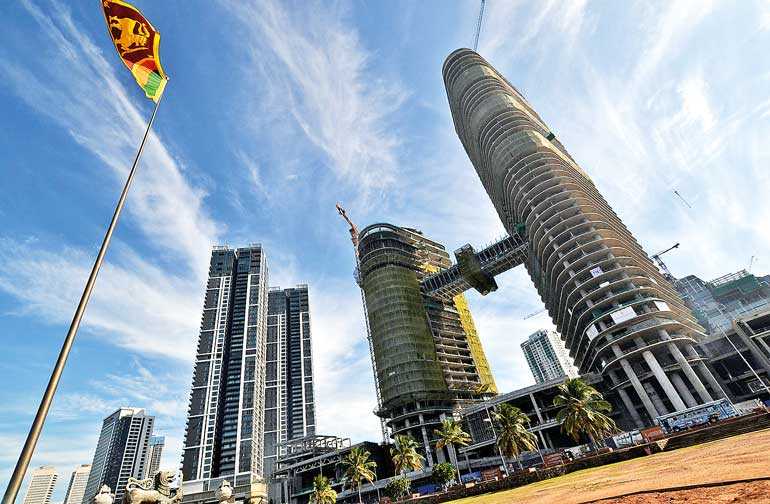Sunday Dec 07, 2025
Sunday Dec 07, 2025
Tuesday, 26 January 2021 00:45 - - {{hitsCtrl.values.hits}}

The pandemic has brought forward new perceptions into the long-term sustainability of urban metropolises and their rapid urbanisation – Pic by Shehan Gunasekara
 Set against the backdrop of a continuing health crisis, governments and organisations are reinvigorating conversations about how smart city technologies can be leveraged to mitigate or avoid future disruptions. In particular, the focus is on how critical data can be used to anticipate events and allocate resources to help build urban resiliency.
Set against the backdrop of a continuing health crisis, governments and organisations are reinvigorating conversations about how smart city technologies can be leveraged to mitigate or avoid future disruptions. In particular, the focus is on how critical data can be used to anticipate events and allocate resources to help build urban resiliency.
The pandemic has brought forward new perceptions into the long-term sustainability of urban metropolises and their rapid urbanisation. Cities continue to attract an influx of people for various reasons—from the promise of better job opportunities to an improved quality of life – leading the United Nations to estimate that 68%1 of the world’s population will live in urban areas by 2050. However, the resulting high population densities provide the ideal conditions for a virus to spread rapidly.
Fighting a twin battle with smart technologies
This story of rapid urbanisation is particularly true here, in South Asia, leaving our governments with the need to tackle a plethora of issues like congestion, poverty, rising inequalities, water scarcity, and rapidly declining air quality levels and safety. In the face of these challenges, the pandemic has brought us to a watershed moment, testing our infrastructures and preparedness as the health crisis escalates, especially in the context of how to support the poor and the vulnerable.
Here in South Asia too, many of our cities face a twin battle—against the pandemic and climate change. As such, there is a need to fast-track city planning with the help of smart technologies to find ways to sustain our large and increasingly more diverse populations in the future.
Fortunately, many of our cities are known as great engines of innovation. Whenever a crisis hits, they have been able to respond by innovating with novel sewage systems, housing guidelines and public parks to improve sanitation and reduce overcrowding. It is encouraging to see this turn towards harnessing technology through smart city projects, to see how cloud, artificial intelligence (AI), Internet of Things (IoT), blockchain, and other emerging technologies might have the power to help.
In Malaysia, for example, the Government has embarked on a smart city initiative, across the Greater Kuala Lumpur, Iskandar Malaysia, Selangor and Putrajaya cities. This project aims to utilise technology to harness data from multiple sources to transform these cities into intelligent ones, allowing for more effective urban management, and in doing so, elevate these cities into attractive investment destinations in the ASEAN region2.
Whereas in Bangladesh, the government, under its digital vision, plans to develop several metropolitan conurbations into smart cities. Here, the ‘Bangladesh Smart City’3 project concentrates its efforts on bringing revolutionary change to cities through the co-creation of smart cities with efforts that integrate citizens’ participation, technology, infrastructure, and public policy.
Building long-term resilience
In fact, the lockdowns and social distancing rules have meant that many populous urban cities in South Asia have adopted new e-government services to make lives easier for their citizens, accelerating this digital transformation.
As a case in point, the Sri Lankan Government launched a cloud-based application called ‘Stay Safe’4 to conduct digital contract tracing to identify and manage the people who have been exposed to COVID-19 to prevent and break the chain of transmission. Via an app, businesses can generate a unique QR-code to display at the entrance for individuals to scan on their smartphone as they ‘check-in’, allowing their details to be collected automatically.
Indeed, urban leaders need to use the pandemic as an opportunity for change and learn from its many lessons how to become more resilient, and see the benefit of acting now.
The future of smart cities
At the same time, the introduction of next-gen technologies like AI, IoT, big data, sensor-driven analytics and blockchain are giving authorities a chance to look at old problems in new ways, with cloud computing making these efforts affordable and realistic. These tools are unearthing hidden data which can be used to assist governments in shifting resource allocation and utilisation to provide improved citizen services and a higher quality of life. Already, many of the cities that have adopted these technologies are seeing less congestion and pollution, as well as improvements in public health, productivity, and living conditions.
And these new technologies are likely to prove increasingly essential. A new global research initiative5 recently shared details suggesting that just becoming a smart city is no longer enough. Instead, the future of smart cities is to be hyperconnected.
As the report from ESI ThoughtLab shares: “To unlock the full economic, social, environmental, and business value from technology, cities need to morph into hyperconnected urban centres: those that use the latest technologies to transform and interconnect key areas of their ecosystem—from roads to cars, buildings to energy grids, citizens to government, and cities to cities. By doing so, urban leaders can fuel a virtuous cycle of economic, business, environmental, and social gains, which in turn will attract additional business, talent, and investment.”
Those cities that are already using these technologies in conjunction with broader and richer sets of data are already driving high performance across their urban ecosystems – from smart buildings and roads to smart energy grids and water systems, and smart mobility, public safety, and health – and facilitating real-time interaction among residents, businesses, and government entities and services.
So, as South Asian countries begin the recovery from the ongoing pandemic, it is essential to define what tomorrow will look like and take stock of our preparedness to face future global crises. It is clear that those smart cities that are built on well thought out and interconnected frameworks are well-positioned to be the agents of change. They will have the potential to lead the way, both in terms of recovery from the pandemic and tackling other key issues, such as climate change, and move forward towards development that is sustainable, resilient and includes everyone.
Footnotes:
1 https://citymonitor.ai/government/how-covid-19-is-shifting-smart-city-priorities
2 Smart City Initiative, Federal Town and Country Planning Department, Malaysian Communications and Multimedia Commission, URL: https://www.mcmc.gov.my/skmmgovmy/media/General/pdf/Sesi-5-Rangkakerja-Berteraskan-Aspek-Informasi-(PLANMalaysia).pdf
3 https://smartcitybangladesh.net/
4 https://covid19.gov.lk/news/general/stay-safe-digital-programme-designed-to-contain-covid-19-introduced-to-president.html
5https://econsultsolutions.com/wp-content/uploads/2019/11/ESITL_Building-a-Hyperconnected-City_Report.pdf
(The writer is the GEO Managing Director – ASEAN and South Asian Growing Economies (SAGE) – Oracle.)